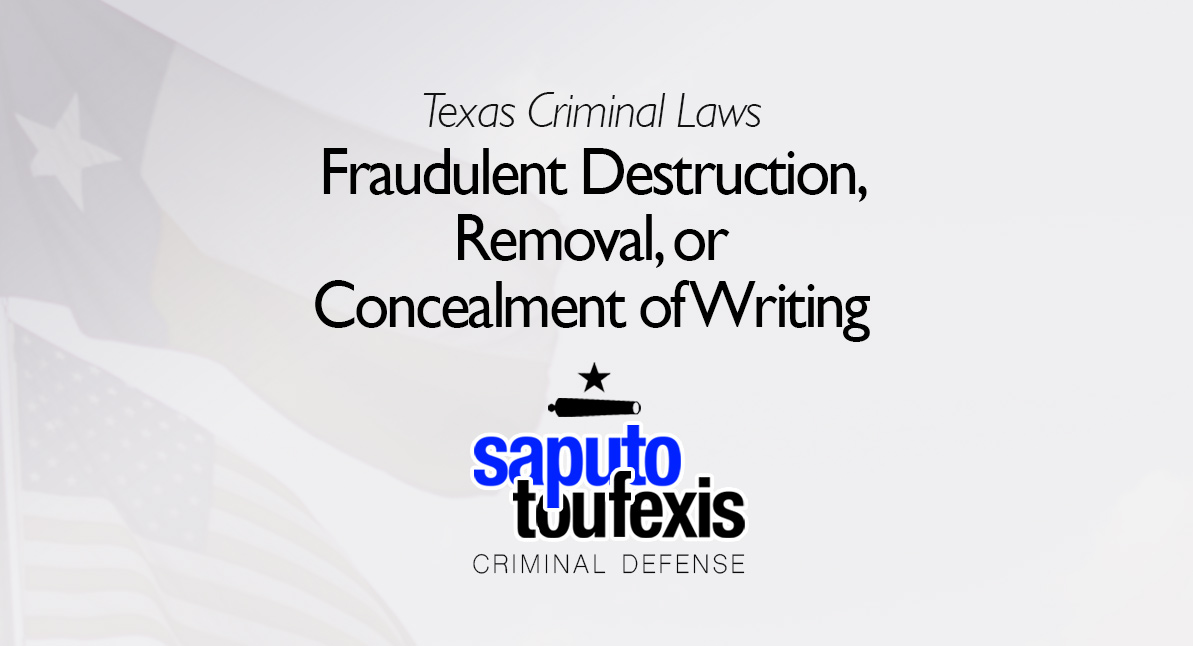The Texas Fraudulent Destruction, Removal, or Concealment of Writing law gives police the right to arrest you if they believe you destroyed or otherwise impaired certain kinds of documents, currency or other types of “writings” (like price tags) unrelated to government records with the intent to defraud.
FAQs about the
Fraudulent Destruction, Removal, or Concealment of Writing law in Texas
- What is the current Texas law about Fraudulent Destruction, Removal, or Concealment of Writing?
- How can I be charged with a Fraudulent Destruction, Removal, or Concealment of Writing offense in Texas?
- What is the statute of limitation for Fraudulent Destruction, Removal, or Concealment of Writing in Texas?
- What is the penalty for a Texas Fraudulent Destruction, Removal, or Concealment of Writing offense?
- Can you get probation for Fraudulent Destruction, Removal, or Concealment of Writing in Texas?
- What level of crime is Fraudulent Destruction, Removal, or Concealment of Writing in Texas?
The Texas legislature codified this criminal offense in Texas Penal Code Section 32.47. The legislature did not update this law in 2023.
Have you been charged with Fraudulent Destruction, Removal, or Concealment of Writing? Book a consultation to discuss legal representation with attorneys Paul Saputo and Nicholas Toufexis today.
The law was most recently amended in 2019 when the penalty scheme for this offense was amended by creating special penalties for price tag switching.
The Penal Code classifies the Texas Fraudulent Destruction, Removal, or Concealment of Writing law under Title 7 “Offenses Against Property,” Chapter 32 “Fraud.” Learn more about the Texas offense of Fraudulent Destruction, Removal, or Concealment of Writing below.
What is the current Texas law about Fraudulent Destruction, Removal, or Concealment of Writing?
Texas law currently defines the offense of Fraudulent Destruction, Removal, or Concealment of Writing in Penal Code Section §32.47 as follows:[1]
(a) A person commits an offense if, with intent to defraud or harm another, he destroys, removes, conceals, alters, substitutes, or otherwise impairs the verity, legibility, or availability of a writing, other than a governmental record.
Writings are defined in the statute to include (the word “include” implies that this is not an exhaustive list):[2]
(1) printing or any other method of recording information;
(2) money, coins, tokens, stamps, seals, credit cards, badges, trademarks;
(3) symbols of value, right, privilege, or identification; and
(4) universal product codes, labels, price tags, or markings on goods.
How can I be charged with a Fraudulent Destruction, Removal, or Concealment of Writing offense in Texas?
You can be charged with Fraudulent Destruction, Removal, or Concealment of Writing in Texas if the state’s attorneys believe that each of the elements of 32.47(a) as described in the section above have been met.
What is the statute of limitation for Fraudulent Destruction, Removal, or Concealment of Writing in Texas?
Misdemeanor level Fraudulent Destruction, Removal, or Concealment of Writing charges have a two-year limitations period.[3] Felony level offenses have a three-year limitations period.[4]
What is the penalty for a Texas Fraudulent Destruction, Removal, or Concealment of Writing offense?
A conviction for Fraudulent Destruction, Removal, or Concealment of Writing is punished by default as a Class A misdemeanor,[5] with a maximum possible fine under Texas state law of up to $4,000 and jail time of up to one year.
However, if the writing is a will, deed, or mortgage, then a conviction for Fraudulent Destruction, Removal, or Concealment of Writing in Texas is punished as a State Jail Felony,[6] with a maximum possible fine under Texas state law of up to $10,000 and jail time of up to two years.
What changed in 2019
The legislature created new penalty classification scheme, effective September 1, 2019, that targets “price tag switching,” and establishes a penalty classification level based on the difference between the value of the item and the amount indicated by the switched tag.[7] The larger the price differential, the harsher the penalty:
If at the time of the offense the writing was attached to tangible property to indicate the price for the sale of that property and the actor engaged in the conduct described by Subsection (a) with respect to that writing for the purpose of obtaining the property for a lesser price indicated by a separate writing, an offense under this section is:
(1) a Class C misdemeanor if the difference between the impaired writing and the lesser price indicated by the other writing is less than $100;
(2) a Class B misdemeanor if the difference between the impaired writing and the lesser price indicated by the other writing is $100 or more but less than $750;
(3) a Class A misdemeanor if the difference between the impaired writing and the lesser price indicated by the other writing is $750 or more but less than $2,500;
(4) a state jail felony if the difference between the impaired writing and the lesser price indicated by the other writing is $2,500 or more but less than $30,000;
(5) a felony of the third degree if the difference between the impaired writing and the lesser price indicated by the other writing is $30,000 or more but less than $150,000;
(6) a felony of the second degree if the difference between the impaired writing and the lesser price indicated by the other writing is $150,000 or more but less than $300,000; or
(7) a felony of the first degree if the difference between the impaired writing and the lesser price indicated by the other writing is $300,000 or more.
Can you get probation for Fraudulent Destruction, Removal, or Concealment of Writing in Texas?
The Texas Code of Criminal Procedure allows both judges and juries to grant probation for Fraudulent Destruction, Removal, or Concealment of Writing, and judges are also allowed to accept deferred adjudication plea deals.[8]
Note, however, that no matter the offense, neither judges nor juries may recommend community supervision for any suspended sentence of over 10 years.[9] Also, judges may not grant community supervision after a conviction if (1) the defendant used or exhibited a deadly weapon during the commission of the felony or immediate flight thereafter and (2) the defendant used or exhibited the deadly weapon himself or was a party to the offense and knew that a deadly weapon would be used or exhibited.[10]
What level of crime is Fraudulent Destruction, Removal, or Concealment of Writing in Texas?
The Penal Code classification of the punishment for Fraudulent Destruction, Removal, or Concealment of Writing ranges from a Class C misdemeanor to a first degree felony, depending on the difference between the real and fake writing and other circumstances.
Learn more about the penalty range for this offense in the section above.
Legal References:
^1. Texas Penal Code §32.47. This law is current as of 2024.^2. Texas Penal Code §32.47(b)^3. Code of Criminal Procedure 12.02(a)^4. See Code of Criminal Procedure 12.01(9)^5. Texas Penal Code §32.47(c)^6. Texas Penal Code §32.47(d)^7. Texas Penal Code §32.47(e), as enacted by HB 427, 86th Texas Legislature, effective September 1, 2019 –^8. See Chapter 42, Texas Code of Criminal Procedure, Art. 42A.054, Art. 42A.056, Art. 42A.102 .^9. Art. 42A.053(c), Texas Code of Criminal Procedure^10. Art. 42A.054(b), Texas Code of Criminal Procedure









